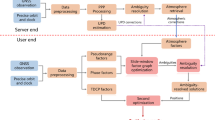Abstract
To overcome the disadvantages of the positioning technologies by fuzzy theory in Wireless Sensor Networks (WSNs), positioning algorithms based on information fusion are presented in this article. The fuzzy theory is used to deal with the randomness and fuzziness in the WSNs. And the information fusion is introduced to improve the location accuracy. If the collinearity of the anchor nodes is larger, the misjudged reference nodes may be caused. They are removed by using clustering method. The algorithms in this paper can enhance the location accuracies compared with using the fuzzy theory and alleviate the effect of the RSSI (Received Signal Strength Indication) measure errors. Moreover, the algorithms avoid the high complexity of computation and the requirement of more anchor nodes. Simulation results indicate that the algorithms are more precise, robust as well as with good suitability.









Similar content being viewed by others
References
AbdelSalam, H. S. (2009). HexNet: Hexagon-based localization technique for wireless sensor networks. In IEEE International Conference on Pervasive Computing and Communications.
Bulusu, N., Heidemann, J., & Estrin, D. (2000). GPS-less low cost outdoor localization for very small devices. IEEE Personal Communications, 7(5), 28–34.
Cao, W.-M., & Wang, R. (2010). The processing method for fuzzy information of coverage and positioning in wireless sensor network (pp. 28–30). Beijing: Publishing House of Electronics Industry.
Dai, G.-L., Zhao, C.-C., & Qiu, Y. (2008). A localization scheme based on sphere for wireless sensor network in 3D. Acta Electronica Sinica, 36(7), 1297–1304.
Fang, Z., Zhao, Z., Guo, P., & Zhang Y.-G. (2007). Analysis of distance measurement based on RSSI. Chinese Journal of Sensors and Actuators, 20(11), 2526–2530.
Fang, Z., Zhao, Z., Geng, D. & Xuan, Y. (2010). Research on a novel fuzzy theory based localization model in WSNs. In Proceedings of the 2010 IEEE international conference on information and automation (pp. 1532–1537).
Forghani, Y. (2008) A new weighted centroid localization algorithm in wireless sensor networks. In Proceedings of 11th international conference on computer and information technology (pp. 89–93).
Li, B., & Wang, H. (2010). A low complexity localization algorithm in wireless sensor network. In CICC-ITOE 2010–2010 international conference on innovative computing and communication (pp. 217–220).
Niculescu, D., & Nath, B. (2001) Ad-hoc positioning systems (APS). In Proceedings of the 2001 IEEE global telecommunications conference San Antonio (pp. 2926–2931).
Ou, C.-H., & Ssu, K.-F. (2008). Sensor positioning determination with flying anchors in three-dimensional wireless sensor networks. IEEE Transactions on Mobile Computing, 7(9), 1184–1197.
Qasem, H. & Reindl, L. (2006). Precise wireless indoor localization with trilateration based on microwave backscatter. In IEEE wireless and microwave technology conference (pp. 83–87). New York: IEEE Electron Device Letters Press.
Sha, C., Wang, R.-C., & Sun, L.-J. (2010). A cooperating localization method based on beacon transfer in wireless sensor networks. Acta Electronica Sinica, 38(11), 2625–2629.
Ssu, K.-F., Ou, C.-H., & Jiau, H. C. (2005). Localization with mobile anchor points in wireless sensor network. IEEE Transactions on Vehicular Technology, 54(3), 1187–1197.
Suomela, J. (2006). Computational complexity of relay placement in sensor networks. Lecture Notes in Computer Science, 3831, 521–529.
Tian, F., Guo, W., & Wang, C. (2008). Robust localizationbased on adjustment of trilateration network for wireless sensor networks. In 2008 international conference on wireless communications, networking and mobile computing (pp. 3400–3403). New York: Institute of Electrical and Electronics Engineers Press.
Wang, S., Yan, Y.-J., & Hu, F.-P. (2007). Wireless sensor network theory and application (pp. 152–154). Beijing: Beijing Aerospace Press.
Yedavalli, K., & Krishnamachari, B. (2008). Sequence-based localization in wireless sensor networks. IEEE Transactions on Mobile Computing, 7(1), 81–94.
Zhu, J., Zhao, H., Xu, J., & Li, D. (2010). Research on a novel fuzzy theory based localization model in WSNs. Acta Electronica Sinica, 38(8), 1845–1851.
Acknowledgments
This work was supported by the Key National Science and Technology Project of China (No. 2010ZX03006-005-01).
Author information
Authors and Affiliations
Corresponding author
Rights and permissions
About this article
Cite this article
Tang, L., Gong, Y., Luo, Y. et al. Positioning Algorithms by Information Fusion in Wireless Sensor Networks. Wireless Pers Commun 74, 545–557 (2014). https://doi.org/10.1007/s11277-013-1305-7
Published:
Issue Date:
DOI: https://doi.org/10.1007/s11277-013-1305-7




